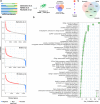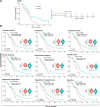Integrated transcriptomics uncovers an enhanced association between the prion protein gene expression and vesicle dynamics signatures in glioblastomas
- PMID: 38347462
- PMCID: PMC10863147
- DOI: 10.1186/s12885-024-11914-6
Integrated transcriptomics uncovers an enhanced association between the prion protein gene expression and vesicle dynamics signatures in glioblastomas
Abstract
Background: Glioblastoma (GBM) is an aggressive brain tumor that exhibits resistance to current treatment, making the identification of novel therapeutic targets essential. In this context, cellular prion protein (PrPC) stands out as a potential candidate for new therapies. Encoded by the PRNP gene, PrPC can present increased expression levels in GBM, impacting cell proliferation, growth, migration, invasion and stemness. Nevertheless, the exact molecular mechanisms through which PRNP/PrPC modulates key aspects of GBM biology remain elusive.
Methods: To elucidate the implications of PRNP/PrPC in the biology of this cancer, we analyzed publicly available RNA sequencing (RNA-seq) data of patient-derived GBMs from four independent studies. First, we ranked samples profiled by bulk RNA-seq as PRNPhigh and PRNPlow and compared their transcriptomic landscape. Then, we analyzed PRNP+ and PRNP- GBM cells profiled by single-cell RNA-seq to further understand the molecular context within which PRNP/PrPC might function in this tumor. We explored an additional proteomics dataset, applying similar comparative approaches, to corroborate our findings.
Results: Functional profiling revealed that vesicular dynamics signatures are strongly correlated with PRNP/PrPC levels in GBM. We found a panel of 73 genes, enriched in vesicle-related pathways, whose expression levels are increased in PRNPhigh/PRNP+ cells across all RNA-seq datasets. Vesicle-associated genes, ANXA1, RAB31, DSTN and SYPL1, were found to be upregulated in vitro in an in-house collection of patient-derived GBM. Moreover, proteome analysis of patient-derived samples reinforces the findings of enhanced vesicle biogenesis, processing and trafficking in PRNPhigh/PRNP+ GBM cells.
Conclusions: Together, our findings shed light on a novel role for PrPC as a potential modulator of vesicle biology in GBM, which is pivotal for intercellular communication and cancer maintenance. We also introduce GBMdiscovery, a novel user-friendly tool that allows the investigation of specific genes in GBM biology.
Keywords: Glioblastoma; Intracellular trafficking; Prion protein; Transcriptomics; Vesicle dynamics.
© 2024. The Author(s).
Conflict of interest statement
The authors declare no competing interests.
Figures







Similar articles
-
Prion protein regulates invasiveness in glioblastoma stem cells.BMC Cancer. 2024 Dec 18;24(1):1539. doi: 10.1186/s12885-024-13285-4. BMC Cancer. 2024. PMID: 39695426 Free PMC article.
-
Engagement of cellular prion protein with the co-chaperone Hsp70/90 organizing protein regulates the proliferation of glioblastoma stem-like cells.Stem Cell Res Ther. 2017 Apr 17;8(1):76. doi: 10.1186/s13287-017-0518-1. Stem Cell Res Ther. 2017. PMID: 28412969 Free PMC article.
-
Endoplasmic reticulum stress induces PRNP prion protein gene expression in breast cancer.Breast Cancer Res. 2013 Mar 12;15(2):R22. doi: 10.1186/bcr3398. Breast Cancer Res. 2013. PMID: 23497519 Free PMC article.
-
The prion gene complex encoding PrP(C) and Doppel: insights from mutational analysis.Gene. 2001 Sep 5;275(1):1-18. doi: 10.1016/s0378-1119(01)00627-8. Gene. 2001. PMID: 11574147 Review.
-
Prion Protein in Glioblastoma Multiforme.Int J Mol Sci. 2019 Oct 15;20(20):5107. doi: 10.3390/ijms20205107. Int J Mol Sci. 2019. PMID: 31618844 Free PMC article. Review.
Cited by
-
The expression of pro-prion, a transmembrane isoform of the prion protein, leads to the constitutive activation of the canonical Wnt/β-catenin pathway to sustain the stem-like phenotype of human glioblastoma cells.Cancer Cell Int. 2024 Dec 23;24(1):426. doi: 10.1186/s12935-024-03581-1. Cancer Cell Int. 2024. PMID: 39716276 Free PMC article.
References
MeSH terms
Substances
Grants and funding
- 2020/07450-5/Fundação de Amparo à Pesquisa do Estado de São Paulo
- 2019/14741-9/Fundação de Amparo à Pesquisa do Estado de São Paulo
- 2020/10671-3/Fundação de Amparo à Pesquisa do Estado de São Paulo
- 2019/14952-0/Fundação de Amparo à Pesquisa do Estado de São Paulo
- 2017/26158-0/Fundação de Amparo à Pesquisa do Estado de São Paulo
- 2019/11097-1/Fundação de Amparo à Pesquisa do Estado de São Paulo
- 2015/03614-5/Fundação de Amparo à Pesquisa do Estado de São Paulo
- 2015/03614-5/Fundação de Amparo à Pesquisa do Estado de São Paulo
- 2018/15557-4/Fundação de Amparo à Pesquisa do Estado de São Paulo
- 101796/2020-0/Conselho Nacional de Desenvolvimento Científico e Tecnológico
- 317214/2021-7/Conselho Nacional de Desenvolvimento Científico e Tecnológico
- 304541/2020-6/Conselho Nacional de Desenvolvimento Científico e Tecnológico
- 409941/2021-2/Conselho Nacional de Desenvolvimento Científico e Tecnológico
LinkOut - more resources
Full Text Sources
Research Materials
Miscellaneous

